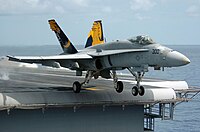
Photo from wikipedia
The control system design for the reusable launch vehicles (RLVs), especially in the autonomous horizontal takeoff phase, is a highly challenging task. Significant issues arise due to the high nonlinearity,… Click to show full abstract
The control system design for the reusable launch vehicles (RLVs), especially in the autonomous horizontal takeoff phase, is a highly challenging task. Significant issues arise due to the high nonlinearity, large uncertainties of aerodynamic coefficients as well as strong coupling among axes of the airframe. This paper studies autonomous takeoff control problem of the RLVs by the means of trajectory linearization control (TLC) and model predictive control (MPC) theory. The six degree of freedom dynamic model is firstly established, and the flight strategy of takeoff and climb stage is provided through the characteristic analysis of RLVs. Furthermore, the guidance law for the climbing phase is proposed via the TLC method against the high nonlinearity, and a speed based gain-schedule strategy is given under the consideration of both aerodynamic force and friction force. In order to eliminate the ground effect interference, an improved model predictive control approach is presented by introducing the online parameter estimation of the ground effect interaction coefficient, and a coupled model predictive controller is designed by introducing the feedback of sideslip angle into the roll control channel to eliminate the coupling effect. Finally, the performance of the design method for autonomous takeoff control of RLVs is demonstrated through the comparison simulation analysis.
Journal Title: IEEE Access
Year Published: 2020
Link to full text (if available)
Share on Social Media: Sign Up to like & get
recommendations!